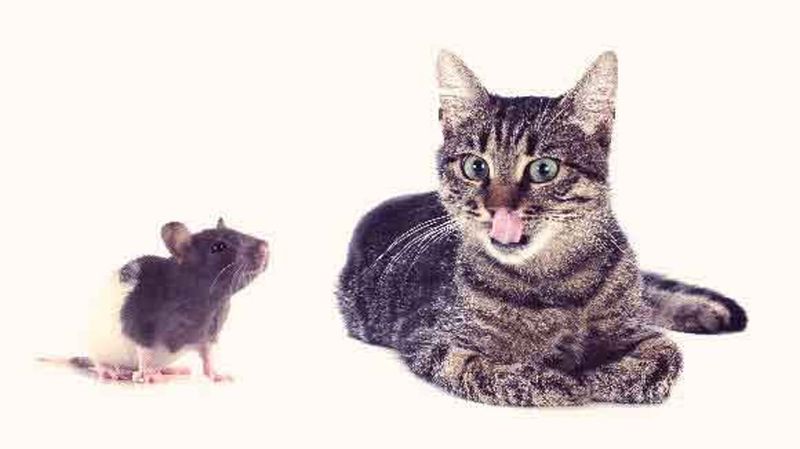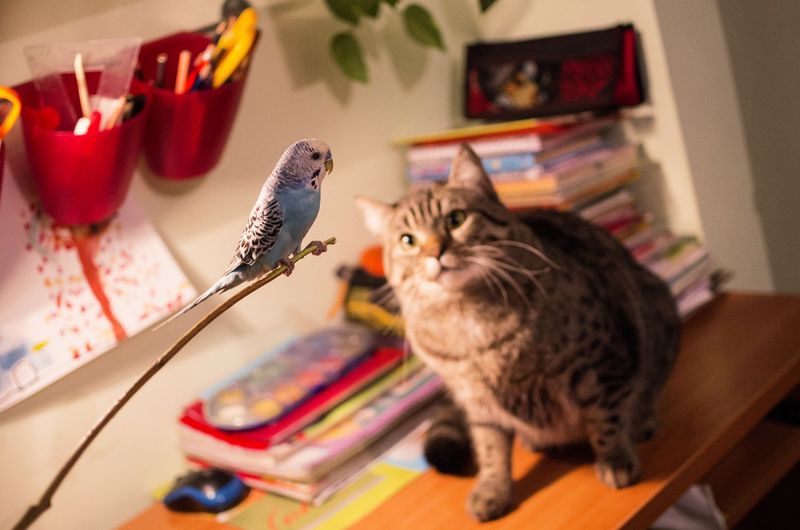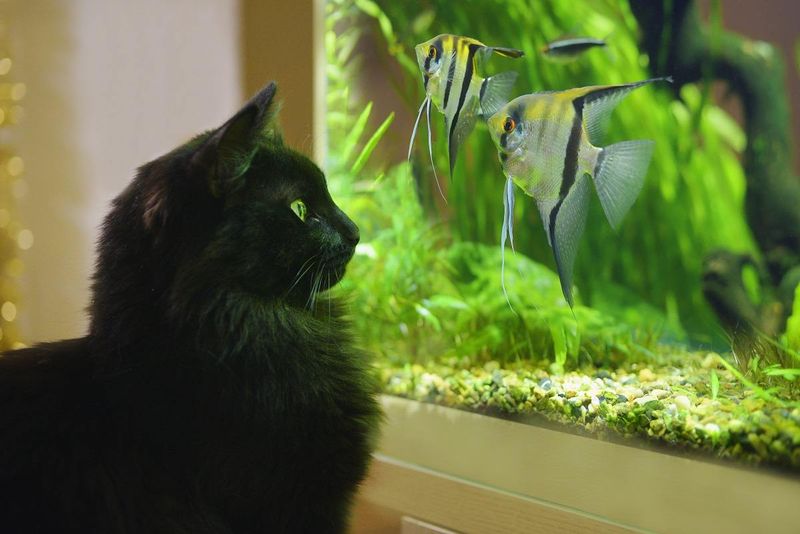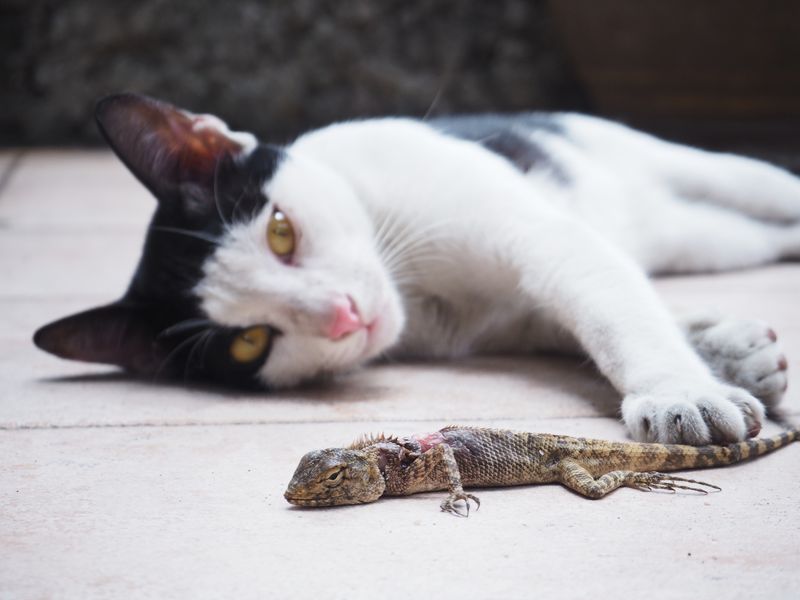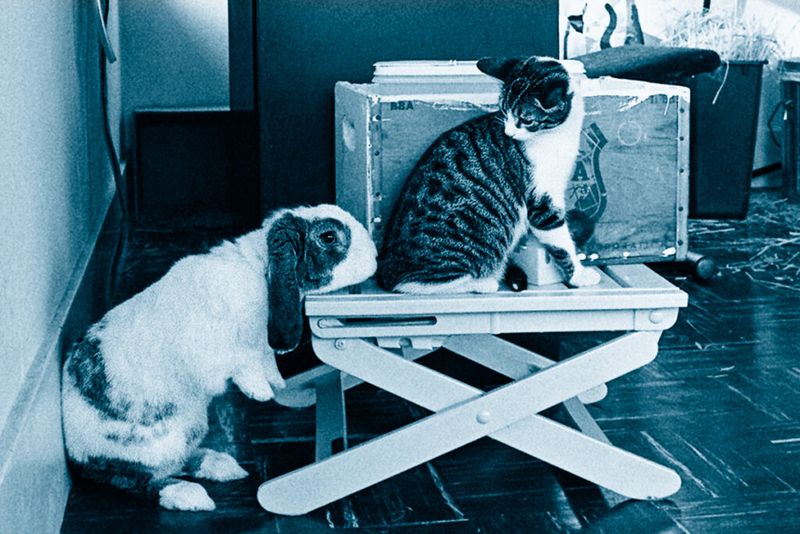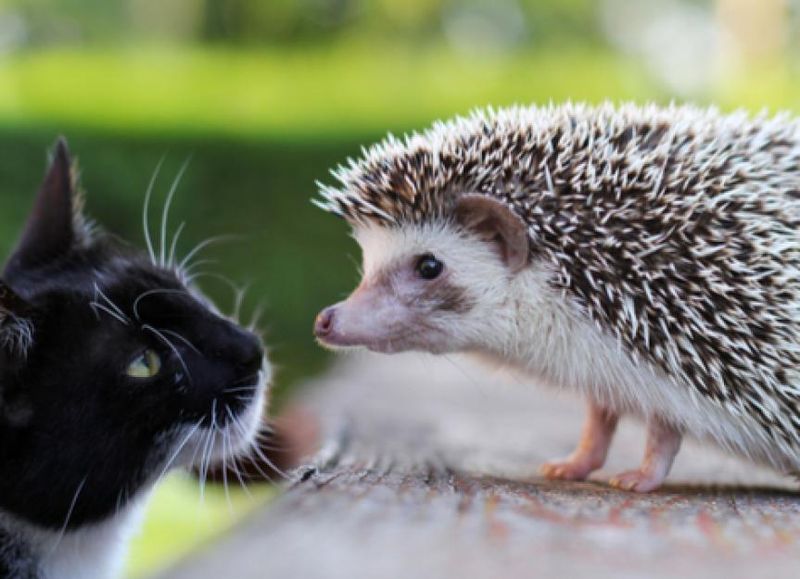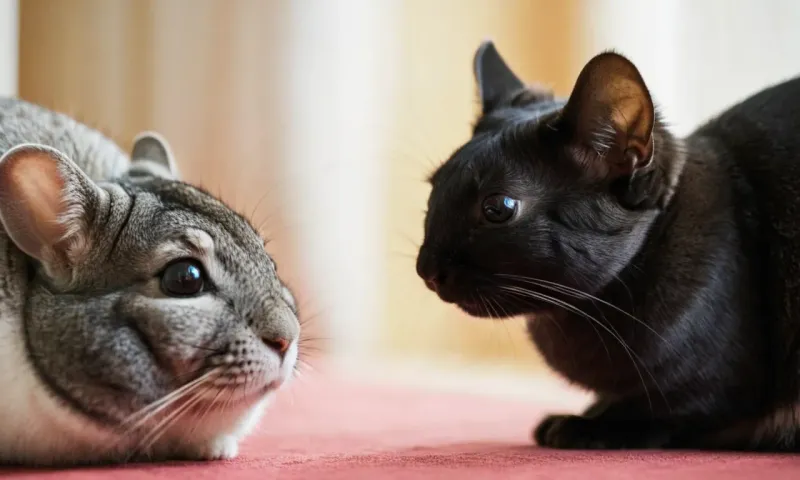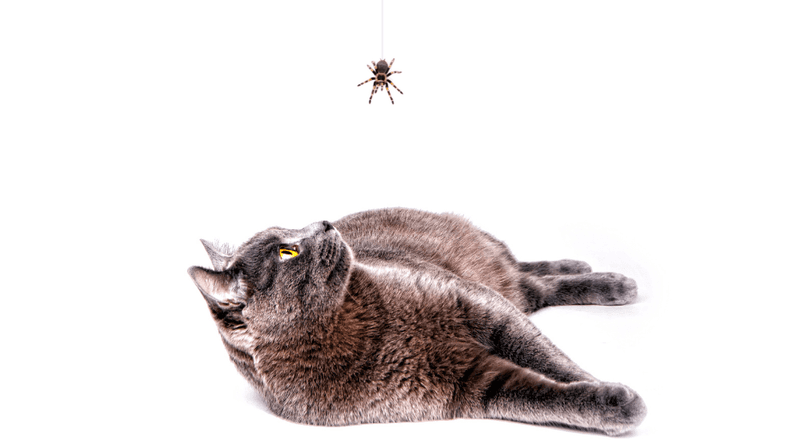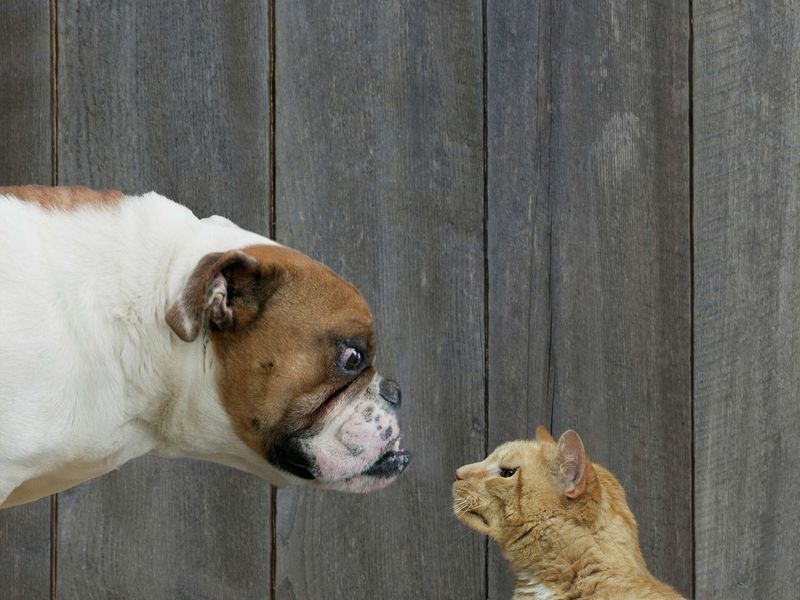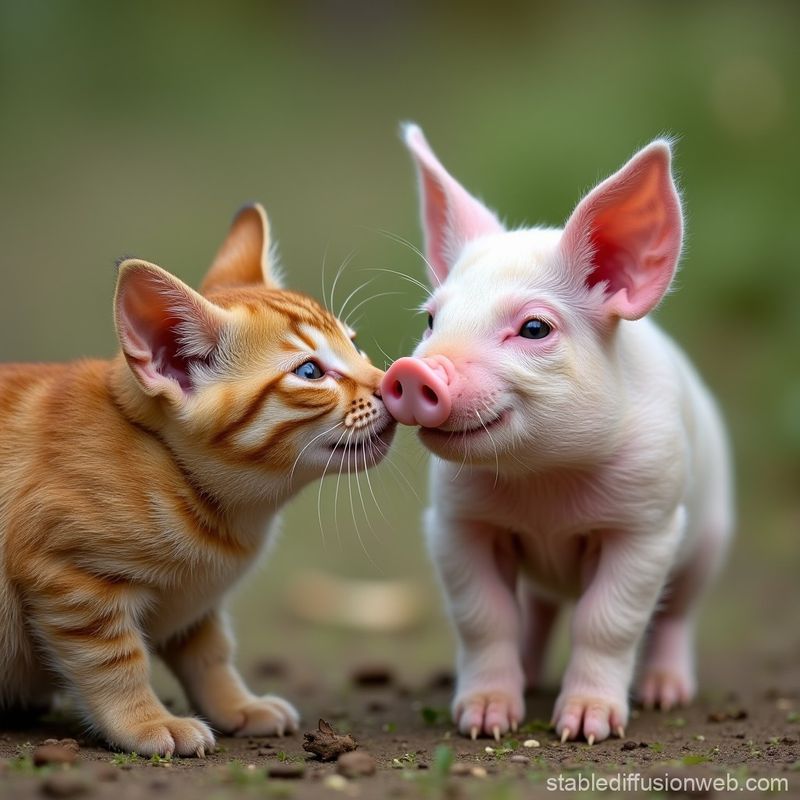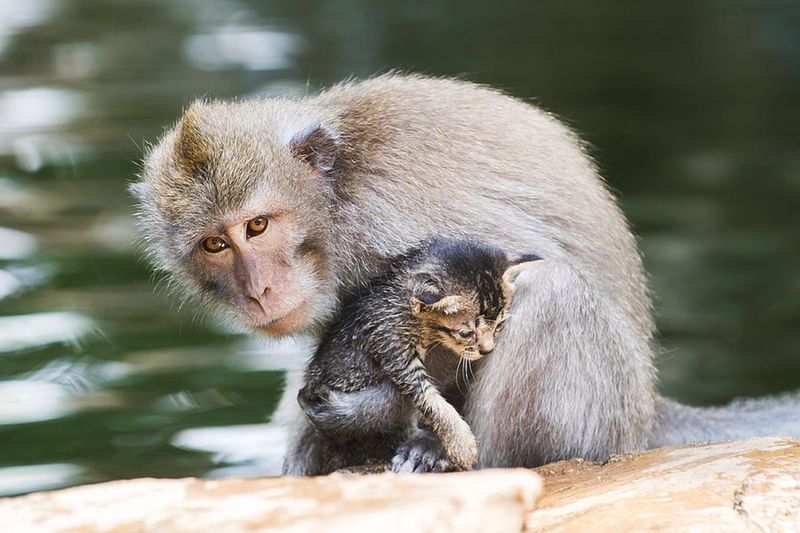📖 Table of Content:
- 1. Small Rodents (Hamsters, Guinea Pigs, Mice, Gerbils, Rats)
- 2. Birds (Parrots, Canaries, Finches)
- 3. Fish
- 4. Reptiles (Lizards, Snakes, Turtles)
- 5. Ferrets
- 6. Rabbits
- 7. Hedgehogs
- 8. Sugar Gliders
- 9. Small Exotic Pets (Chinchillas, Small Frogs)
- 10. Insects and Arachnids
- 11. Dogs (Some Breeds)
- 12. Goats
- 13. Pigs (Miniature and Standard)
- 14. Monkeys
Not all pets play nice with cats—and some combinations can lead to serious stress or even danger. In this post, we explore 14 animals that typically don’t get along with feline companions, whether due to instinctual behavior, territorial conflicts, or safety concerns. Before you expand your pet family, find out which species are best kept apart from your curious cat—and why doing your homework can lead to a happier, more peaceful home for everyone.
1. Small Rodents (Hamsters, Guinea Pigs, Mice, Gerbils, Rats)
Small rodents like hamsters and guinea pigs can trigger a cat’s hunting instincts. Despite secure enclosures, their presence often causes stress for both the cat and the rodent. Imagine a cat, eyes wide with curiosity, watching a tiny gerbil scurry about. This scenario can lead to anxiety and potential harm. The sound of small rodents rustling in their cages can keep a cat on edge. Additionally, the sight of these little creatures may be too tempting for a cat to resist. Such dynamics make peaceful coexistence a challenge in mixed-species households.
2. Birds (Parrots, Canaries, Finches)
Birds, with their vibrant feathers and melodious songs, can be irresistible to a cat’s predatory nature. The constant presence of a feline can stress the bird, even if protected by a sturdy cage. Picture a cat, tail twitching, as it watches a canary flit about. This can lead to heightened anxiety for the bird. Birds perceive cats as predators, leading to a tense environment. Despite precautions, a cat’s curiosity might result in attempts to paw at the cage. Such interactions are hardly ideal for a serene household.
3. Fish
Fish tanks can become focal points for cats, mesmerized by the darting movements of fish. The allure of a bubbling aquarium may prove too tempting for a curious feline. Cats may paw at the tank, causing stress for the fish. Imagine a cat perched beside an aquarium, eyes fixated on its inhabitants. Such interactions can lead to a chaotic environment. Fish are sensitive to vibrations, and a cat’s activities can disturb their tranquil habitat. It’s a challenging mix for a household seeking harmony between pets.
4. Reptiles (Lizards, Snakes, Turtles)
Reptiles, with their unique behaviors and habitat needs, can be unwittingly disturbed by cats. Consider a cat, its eyes gleaming with curiosity, watching a turtle lumber about. Reptiles require specific environmental conditions that cats may disrupt. The stress of being watched by a predator-like cat can be overwhelming for these cold-blooded creatures. Reptile enclosures might not withstand a determined cat’s curiosity. This dynamic poses risks for both the reptile and the peace of the household. It’s important to carefully consider compatibility.
5. Ferrets
Known for their boundless energy, can inadvertently trigger a cat’s prey instincts. Visualize a ferret darting around with a cat crouched, ready to pounce. Such high-energy interactions can be unpredictable. While some ferrets and cats may tolerate each other, the risk of stress or injury remains. Ferrets’ quick movements and playful antics often entice cats to chase. Maintaining peace between such dynamic creatures requires constant vigilance. This combination can be challenging for those desiring a calm household.
6. Rabbits
Rabbits, with their timid demeanor, don’t always mesh well with a cat’s predatory instincts. Envision a cat stealthily stalking a rabbit, eyes locked in a playful yet tense standoff. While some rabbits and cats can become companions, it requires significant effort and supervision. Cats might chase or pounce on rabbits, causing stress. Rabbits perceive cats as threats, often leading to anxiety. This dynamic demands careful management to ensure both animals’ well-being. Achieving harmony in such households requires dedication and patience.
7. Hedgehogs
Hedgehogs, with their spiky defenses, might deter but not entirely ward off a cat’s curiosity. Imagine a hedgehog, quills at the ready, while a cat sniffs inquisitively. Cats might be unable to physically harm hedgehogs, but their presence can cause stress. Hedgehogs’ small size and scurrying movements can attract unwanted feline attention. Such interactions can lead to an uneasy environment. Managing these dynamics requires creating a safe, stress-free space for both pets. Ensuring peace demands careful planning and understanding.
8. Sugar Gliders
Sugar gliders, with their nocturnal habits, can clash with a cat’s curious nature. Picture a sugar glider gliding gracefully while a cat watches, eyes wide with interest. Despite secure enclosures, cats may spend hours observing or pawing at the cage. This can frighten sugar gliders, who require calm environments. The constant presence of a cat can be unsettling for these delicate creatures. Ensuring a harmonious relationship demands significant attention to each pet’s needs. It’s a complex mix that requires diligence.
9. Small Exotic Pets (Chinchillas, Small Frogs)
Small exotic pets like chinchillas, with their soft fur and gentle demeanor, can inadvertently stir a cat’s instincts. Imagine a chinchilla, eyes wide, as a cat watches with intent. Such dynamics can create stress for the chinchilla, sensitive to disturbances. Cats may paw at cages or try to play, causing unease. These pets require a peaceful environment to thrive. Achieving harmony in such households involves careful management and understanding of each species’ needs. It’s a balancing act requiring dedication and adaptation.
10. Insects and Arachnids
Exotic pets like tarantulas may intrigue but are unsuitable companions for cats. Visualize a cat’s paw gently tapping on the glass of a spider’s terrarium. Such interactions can lead to stress for both creatures. Many insects are fragile, while some, like scorpions, can potentially harm your cat. Despite being in secure enclosures, the dynamic creates tension. Cats, driven by curiosity, might accidentally harm these pets. Ensuring safety and harmony in this scenario demands constant attention and care. It’s a delicate balance to maintain.
11. Dogs (Some Breeds)
Not all dog breeds harmonize with cats due to differing temperaments and energy levels. Consider a boisterous dog attempting to play with a cautious cat. Such interactions can lead to stress. While many dogs can coexist with cats, breeds with strong prey drives or territorial instincts may pose challenges. Ensuring compatibility involves observing interactions and slowly introducing them. Creating a peaceful environment requires understanding the distinct personalities of your pets. It’s about finding the right balance and fostering respect between the species.
12. Goats
Goats, with their playful antics and curious nature, may not mix well with cats. Imagine a goat romping in a field while a cat observes from afar. Goats’ larger size and energetic behavior can intimidate or provoke cats. The playful nature of goats may unintentionally cause stress for felines. Effective management of such a household requires careful supervision and understanding of each animal’s temperament. Ensuring harmony involves balancing the needs and personalities of both species. It requires patience and adaptability to foster a peaceful coexistence.
13. Pigs (Miniature and Standard)
Pigs, both miniature and standard, can create a challenging dynamic in a cat-inclusive household. Picture a pig rooting in the garden with a cat observing warily. Their social and curious nature might clash with a cat’s more reserved demeanor. Pigs’ size and activity level can be intimidating for some cats. Ensuring peace requires understanding the distinct needs and behaviors of each species. This combination demands careful observation and management to maintain harmony. It’s about finding common ground and fostering mutual respect.
14. Monkeys
Monkeys, with their intelligence and energy, require specific care that may not align with a cat’s environment. Envision a monkey swinging joyfully while a cat watches, intrigued. Such high-energy behaviors can unsettle a cat. Monkeys’ social and active nature may lead to risky interactions. Ensuring a harmonious household demands significant effort and understanding of both species. Their differing needs and behaviors can create a challenging dynamic. Creating peace involves adapting the environment to cater to both, ensuring safety and comfort.

